Comprehensive Analysis: Reservoir Engineering II Assignment 1
VerifiedAdded on 2022/08/14
|15
|3897
|15
Homework Assignment
AI Summary
This assignment solution addresses the critical role of Special Core Analysis (SCAL) data in reservoir engineering. It explores the importance of SCAL data compared to conventional core analysis, well logging, and well testing, emphasizing its significance in static/dynamic reservoir modeling and microscale characterization. The solution details the role of SCAL data in oil, gas, and gas-condensate reservoirs, as well as unconventional reservoirs, while also acknowledging the limitations of SCAL data. The assignment further examines the influence of rock mineralogy, water composition, pressure, temperature, oil composition, Swi layer thickness, and diagenesis on reservoir rock wettability, relative permeability, and capillary pressure. Finally, it discusses the interaction between pore structure, wettability, capillary forces, saturation history, and phase viscosities on relative permeability. The solution thoroughly answers the questions presented in the assignment brief, providing a comprehensive overview of SCAL data analysis in reservoir engineering.
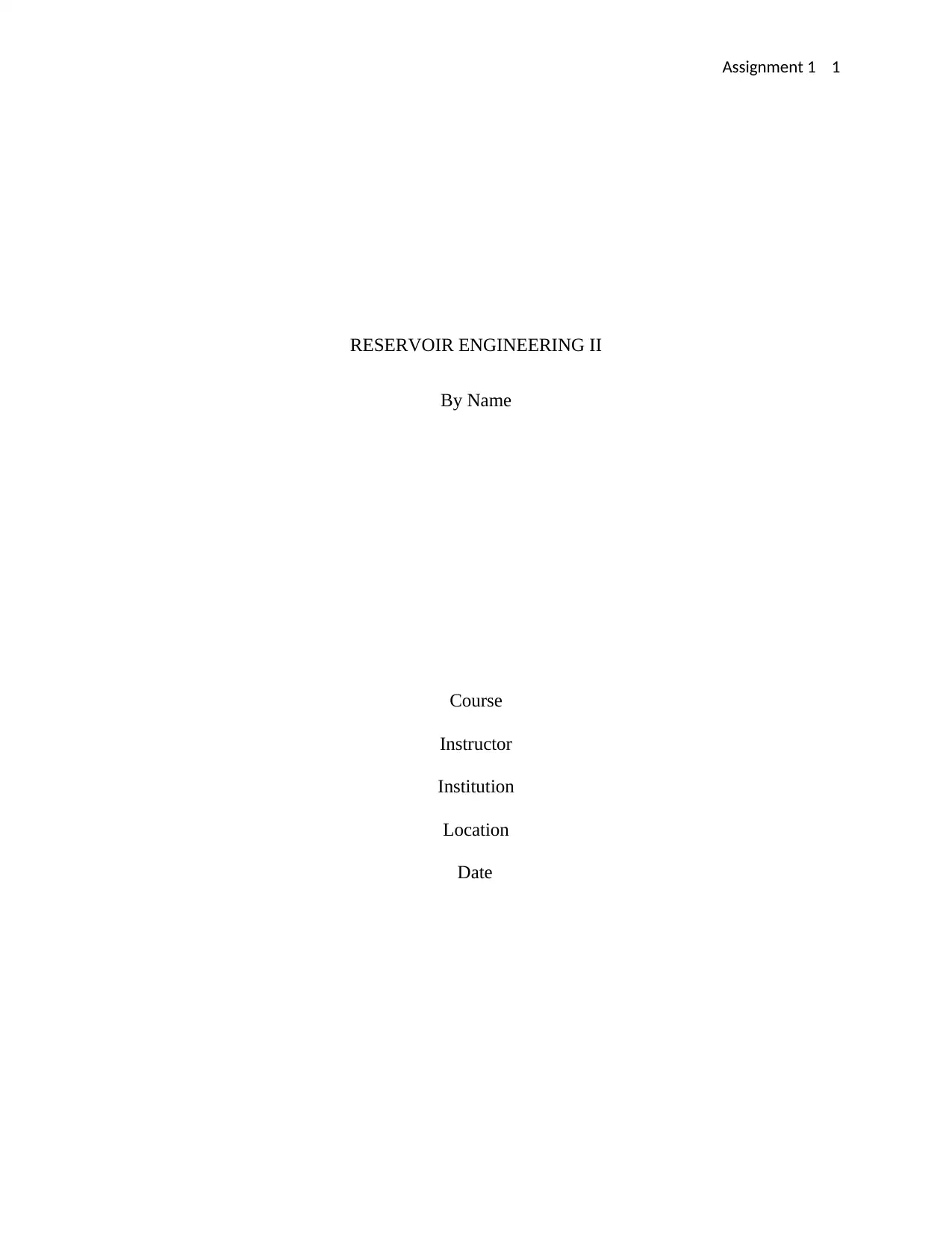
Assignment 1 1
RESERVOIR ENGINEERING II
By Name
Course
Instructor
Institution
Location
Date
RESERVOIR ENGINEERING II
By Name
Course
Instructor
Institution
Location
Date
Paraphrase This Document
Need a fresh take? Get an instant paraphrase of this document with our AI Paraphraser
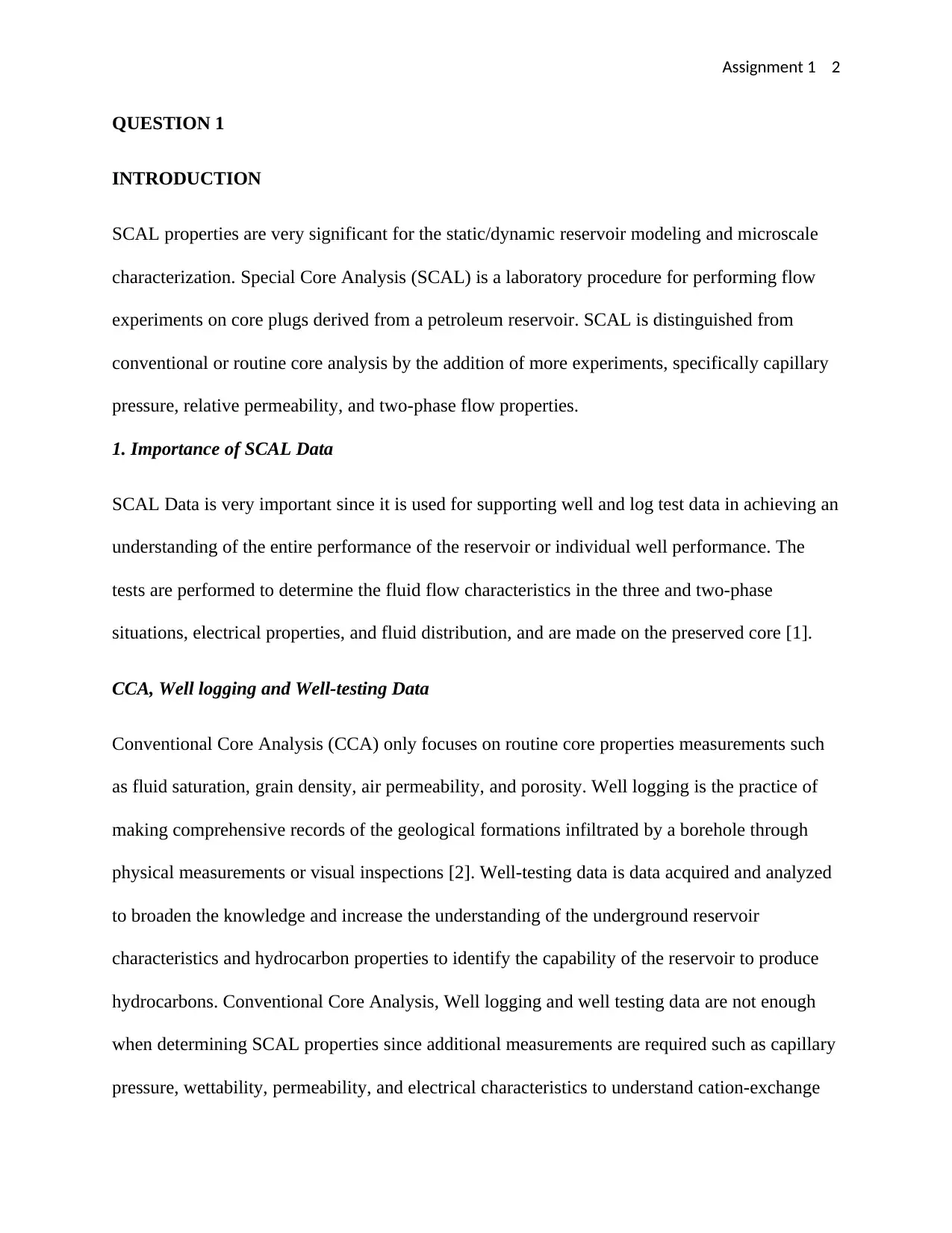
Assignment 1 2
QUESTION 1
INTRODUCTION
SCAL properties are very significant for the static/dynamic reservoir modeling and microscale
characterization. Special Core Analysis (SCAL) is a laboratory procedure for performing flow
experiments on core plugs derived from a petroleum reservoir. SCAL is distinguished from
conventional or routine core analysis by the addition of more experiments, specifically capillary
pressure, relative permeability, and two-phase flow properties.
1. Importance of SCAL Data
SCAL Data is very important since it is used for supporting well and log test data in achieving an
understanding of the entire performance of the reservoir or individual well performance. The
tests are performed to determine the fluid flow characteristics in the three and two-phase
situations, electrical properties, and fluid distribution, and are made on the preserved core [1].
CCA, Well logging and Well-testing Data
Conventional Core Analysis (CCA) only focuses on routine core properties measurements such
as fluid saturation, grain density, air permeability, and porosity. Well logging is the practice of
making comprehensive records of the geological formations infiltrated by a borehole through
physical measurements or visual inspections [2]. Well-testing data is data acquired and analyzed
to broaden the knowledge and increase the understanding of the underground reservoir
characteristics and hydrocarbon properties to identify the capability of the reservoir to produce
hydrocarbons. Conventional Core Analysis, Well logging and well testing data are not enough
when determining SCAL properties since additional measurements are required such as capillary
pressure, wettability, permeability, and electrical characteristics to understand cation-exchange
QUESTION 1
INTRODUCTION
SCAL properties are very significant for the static/dynamic reservoir modeling and microscale
characterization. Special Core Analysis (SCAL) is a laboratory procedure for performing flow
experiments on core plugs derived from a petroleum reservoir. SCAL is distinguished from
conventional or routine core analysis by the addition of more experiments, specifically capillary
pressure, relative permeability, and two-phase flow properties.
1. Importance of SCAL Data
SCAL Data is very important since it is used for supporting well and log test data in achieving an
understanding of the entire performance of the reservoir or individual well performance. The
tests are performed to determine the fluid flow characteristics in the three and two-phase
situations, electrical properties, and fluid distribution, and are made on the preserved core [1].
CCA, Well logging and Well-testing Data
Conventional Core Analysis (CCA) only focuses on routine core properties measurements such
as fluid saturation, grain density, air permeability, and porosity. Well logging is the practice of
making comprehensive records of the geological formations infiltrated by a borehole through
physical measurements or visual inspections [2]. Well-testing data is data acquired and analyzed
to broaden the knowledge and increase the understanding of the underground reservoir
characteristics and hydrocarbon properties to identify the capability of the reservoir to produce
hydrocarbons. Conventional Core Analysis, Well logging and well testing data are not enough
when determining SCAL properties since additional measurements are required such as capillary
pressure, wettability, permeability, and electrical characteristics to understand cation-exchange
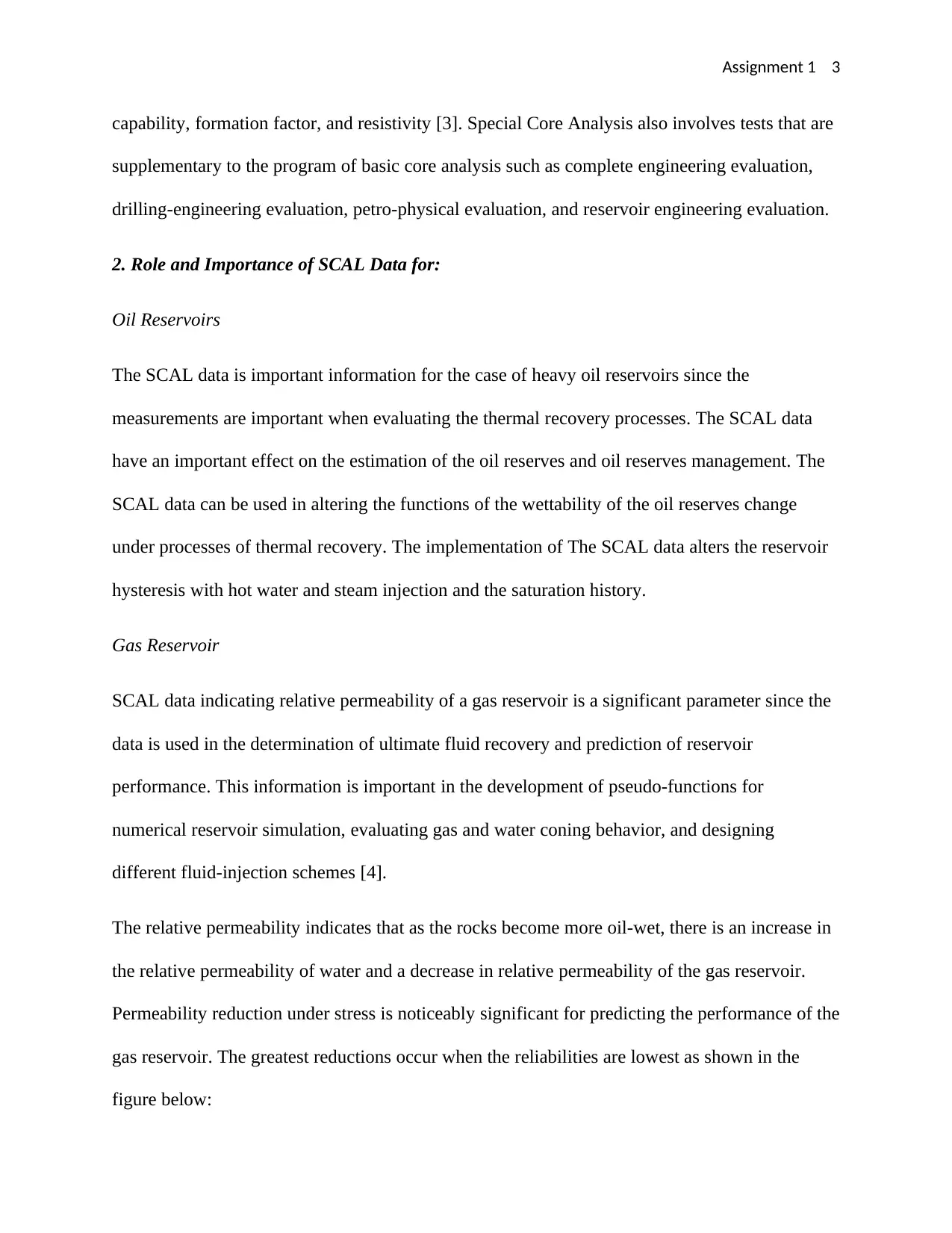
Assignment 1 3
capability, formation factor, and resistivity [3]. Special Core Analysis also involves tests that are
supplementary to the program of basic core analysis such as complete engineering evaluation,
drilling-engineering evaluation, petro-physical evaluation, and reservoir engineering evaluation.
2. Role and Importance of SCAL Data for:
Oil Reservoirs
The SCAL data is important information for the case of heavy oil reservoirs since the
measurements are important when evaluating the thermal recovery processes. The SCAL data
have an important effect on the estimation of the oil reserves and oil reserves management. The
SCAL data can be used in altering the functions of the wettability of the oil reserves change
under processes of thermal recovery. The implementation of The SCAL data alters the reservoir
hysteresis with hot water and steam injection and the saturation history.
Gas Reservoir
SCAL data indicating relative permeability of a gas reservoir is a significant parameter since the
data is used in the determination of ultimate fluid recovery and prediction of reservoir
performance. This information is important in the development of pseudo-functions for
numerical reservoir simulation, evaluating gas and water coning behavior, and designing
different fluid-injection schemes [4].
The relative permeability indicates that as the rocks become more oil-wet, there is an increase in
the relative permeability of water and a decrease in relative permeability of the gas reservoir.
Permeability reduction under stress is noticeably significant for predicting the performance of the
gas reservoir. The greatest reductions occur when the reliabilities are lowest as shown in the
figure below:
capability, formation factor, and resistivity [3]. Special Core Analysis also involves tests that are
supplementary to the program of basic core analysis such as complete engineering evaluation,
drilling-engineering evaluation, petro-physical evaluation, and reservoir engineering evaluation.
2. Role and Importance of SCAL Data for:
Oil Reservoirs
The SCAL data is important information for the case of heavy oil reservoirs since the
measurements are important when evaluating the thermal recovery processes. The SCAL data
have an important effect on the estimation of the oil reserves and oil reserves management. The
SCAL data can be used in altering the functions of the wettability of the oil reserves change
under processes of thermal recovery. The implementation of The SCAL data alters the reservoir
hysteresis with hot water and steam injection and the saturation history.
Gas Reservoir
SCAL data indicating relative permeability of a gas reservoir is a significant parameter since the
data is used in the determination of ultimate fluid recovery and prediction of reservoir
performance. This information is important in the development of pseudo-functions for
numerical reservoir simulation, evaluating gas and water coning behavior, and designing
different fluid-injection schemes [4].
The relative permeability indicates that as the rocks become more oil-wet, there is an increase in
the relative permeability of water and a decrease in relative permeability of the gas reservoir.
Permeability reduction under stress is noticeably significant for predicting the performance of the
gas reservoir. The greatest reductions occur when the reliabilities are lowest as shown in the
figure below:
⊘ This is a preview!⊘
Do you want full access?
Subscribe today to unlock all pages.

Trusted by 1+ million students worldwide
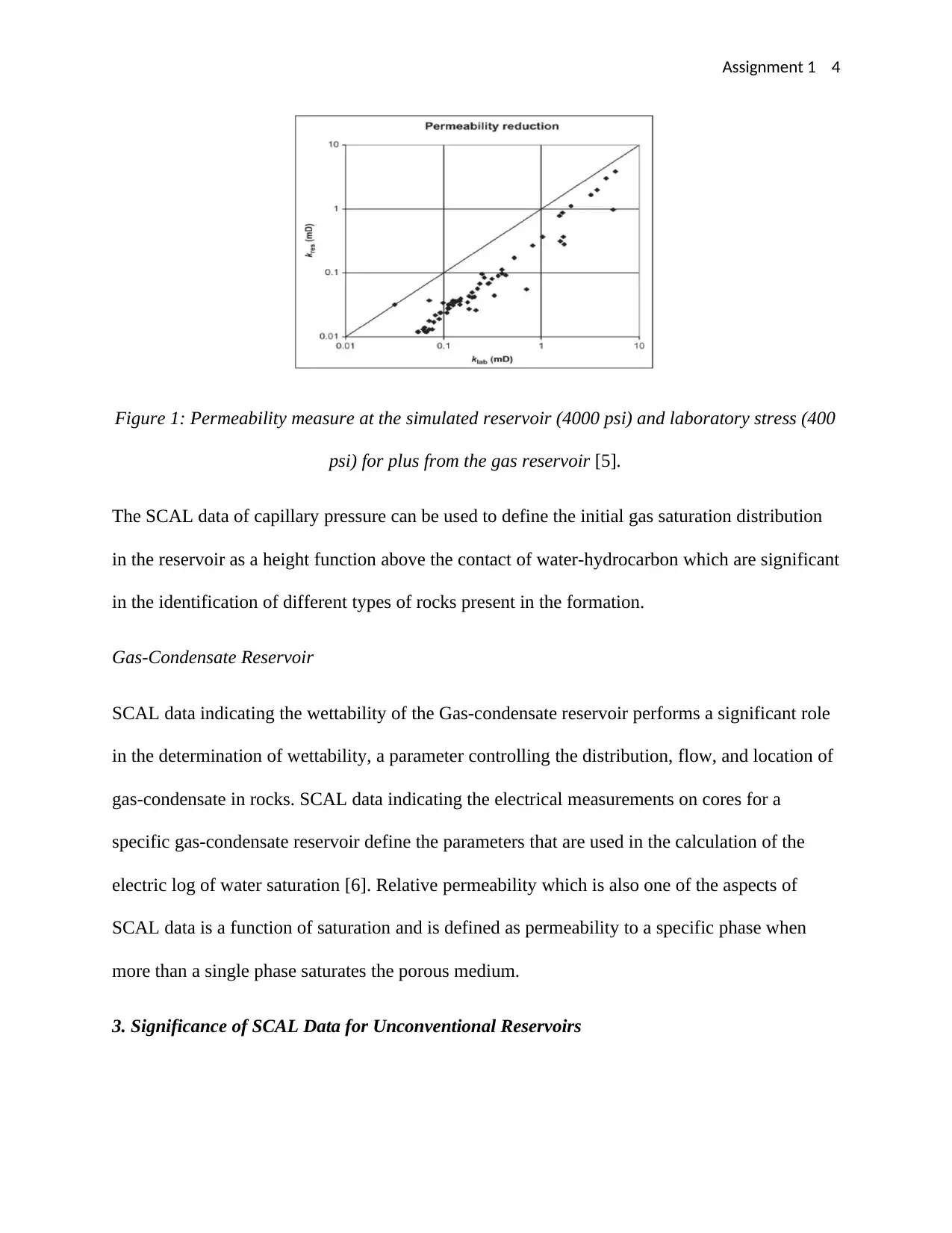
Assignment 1 4
Figure 1: Permeability measure at the simulated reservoir (4000 psi) and laboratory stress (400
psi) for plus from the gas reservoir [5].
The SCAL data of capillary pressure can be used to define the initial gas saturation distribution
in the reservoir as a height function above the contact of water-hydrocarbon which are significant
in the identification of different types of rocks present in the formation.
Gas-Condensate Reservoir
SCAL data indicating the wettability of the Gas-condensate reservoir performs a significant role
in the determination of wettability, a parameter controlling the distribution, flow, and location of
gas-condensate in rocks. SCAL data indicating the electrical measurements on cores for a
specific gas-condensate reservoir define the parameters that are used in the calculation of the
electric log of water saturation [6]. Relative permeability which is also one of the aspects of
SCAL data is a function of saturation and is defined as permeability to a specific phase when
more than a single phase saturates the porous medium.
3. Significance of SCAL Data for Unconventional Reservoirs
Figure 1: Permeability measure at the simulated reservoir (4000 psi) and laboratory stress (400
psi) for plus from the gas reservoir [5].
The SCAL data of capillary pressure can be used to define the initial gas saturation distribution
in the reservoir as a height function above the contact of water-hydrocarbon which are significant
in the identification of different types of rocks present in the formation.
Gas-Condensate Reservoir
SCAL data indicating the wettability of the Gas-condensate reservoir performs a significant role
in the determination of wettability, a parameter controlling the distribution, flow, and location of
gas-condensate in rocks. SCAL data indicating the electrical measurements on cores for a
specific gas-condensate reservoir define the parameters that are used in the calculation of the
electric log of water saturation [6]. Relative permeability which is also one of the aspects of
SCAL data is a function of saturation and is defined as permeability to a specific phase when
more than a single phase saturates the porous medium.
3. Significance of SCAL Data for Unconventional Reservoirs
Paraphrase This Document
Need a fresh take? Get an instant paraphrase of this document with our AI Paraphraser
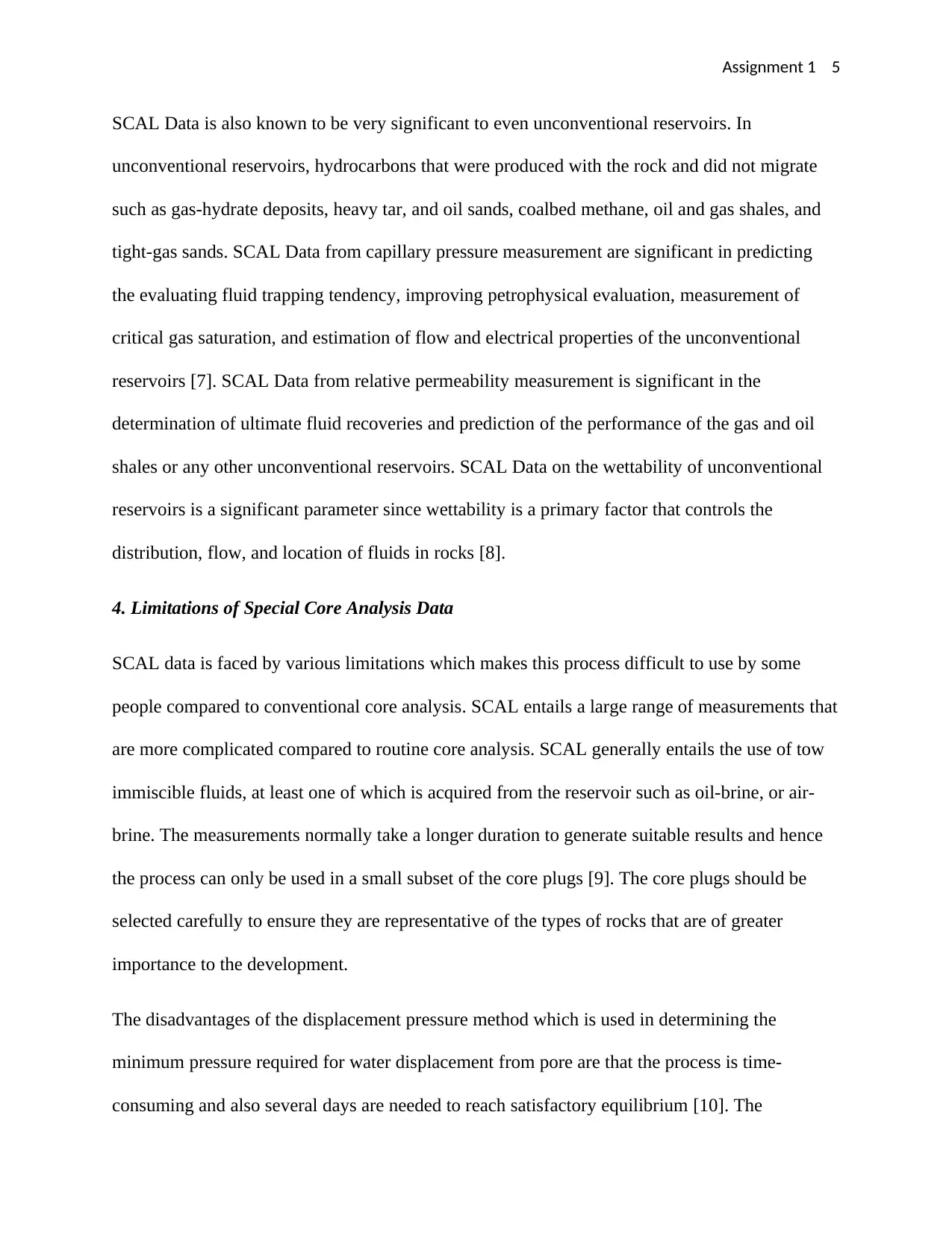
Assignment 1 5
SCAL Data is also known to be very significant to even unconventional reservoirs. In
unconventional reservoirs, hydrocarbons that were produced with the rock and did not migrate
such as gas-hydrate deposits, heavy tar, and oil sands, coalbed methane, oil and gas shales, and
tight-gas sands. SCAL Data from capillary pressure measurement are significant in predicting
the evaluating fluid trapping tendency, improving petrophysical evaluation, measurement of
critical gas saturation, and estimation of flow and electrical properties of the unconventional
reservoirs [7]. SCAL Data from relative permeability measurement is significant in the
determination of ultimate fluid recoveries and prediction of the performance of the gas and oil
shales or any other unconventional reservoirs. SCAL Data on the wettability of unconventional
reservoirs is a significant parameter since wettability is a primary factor that controls the
distribution, flow, and location of fluids in rocks [8].
4. Limitations of Special Core Analysis Data
SCAL data is faced by various limitations which makes this process difficult to use by some
people compared to conventional core analysis. SCAL entails a large range of measurements that
are more complicated compared to routine core analysis. SCAL generally entails the use of tow
immiscible fluids, at least one of which is acquired from the reservoir such as oil-brine, or air-
brine. The measurements normally take a longer duration to generate suitable results and hence
the process can only be used in a small subset of the core plugs [9]. The core plugs should be
selected carefully to ensure they are representative of the types of rocks that are of greater
importance to the development.
The disadvantages of the displacement pressure method which is used in determining the
minimum pressure required for water displacement from pore are that the process is time-
consuming and also several days are needed to reach satisfactory equilibrium [10]. The
SCAL Data is also known to be very significant to even unconventional reservoirs. In
unconventional reservoirs, hydrocarbons that were produced with the rock and did not migrate
such as gas-hydrate deposits, heavy tar, and oil sands, coalbed methane, oil and gas shales, and
tight-gas sands. SCAL Data from capillary pressure measurement are significant in predicting
the evaluating fluid trapping tendency, improving petrophysical evaluation, measurement of
critical gas saturation, and estimation of flow and electrical properties of the unconventional
reservoirs [7]. SCAL Data from relative permeability measurement is significant in the
determination of ultimate fluid recoveries and prediction of the performance of the gas and oil
shales or any other unconventional reservoirs. SCAL Data on the wettability of unconventional
reservoirs is a significant parameter since wettability is a primary factor that controls the
distribution, flow, and location of fluids in rocks [8].
4. Limitations of Special Core Analysis Data
SCAL data is faced by various limitations which makes this process difficult to use by some
people compared to conventional core analysis. SCAL entails a large range of measurements that
are more complicated compared to routine core analysis. SCAL generally entails the use of tow
immiscible fluids, at least one of which is acquired from the reservoir such as oil-brine, or air-
brine. The measurements normally take a longer duration to generate suitable results and hence
the process can only be used in a small subset of the core plugs [9]. The core plugs should be
selected carefully to ensure they are representative of the types of rocks that are of greater
importance to the development.
The disadvantages of the displacement pressure method which is used in determining the
minimum pressure required for water displacement from pore are that the process is time-
consuming and also several days are needed to reach satisfactory equilibrium [10]. The
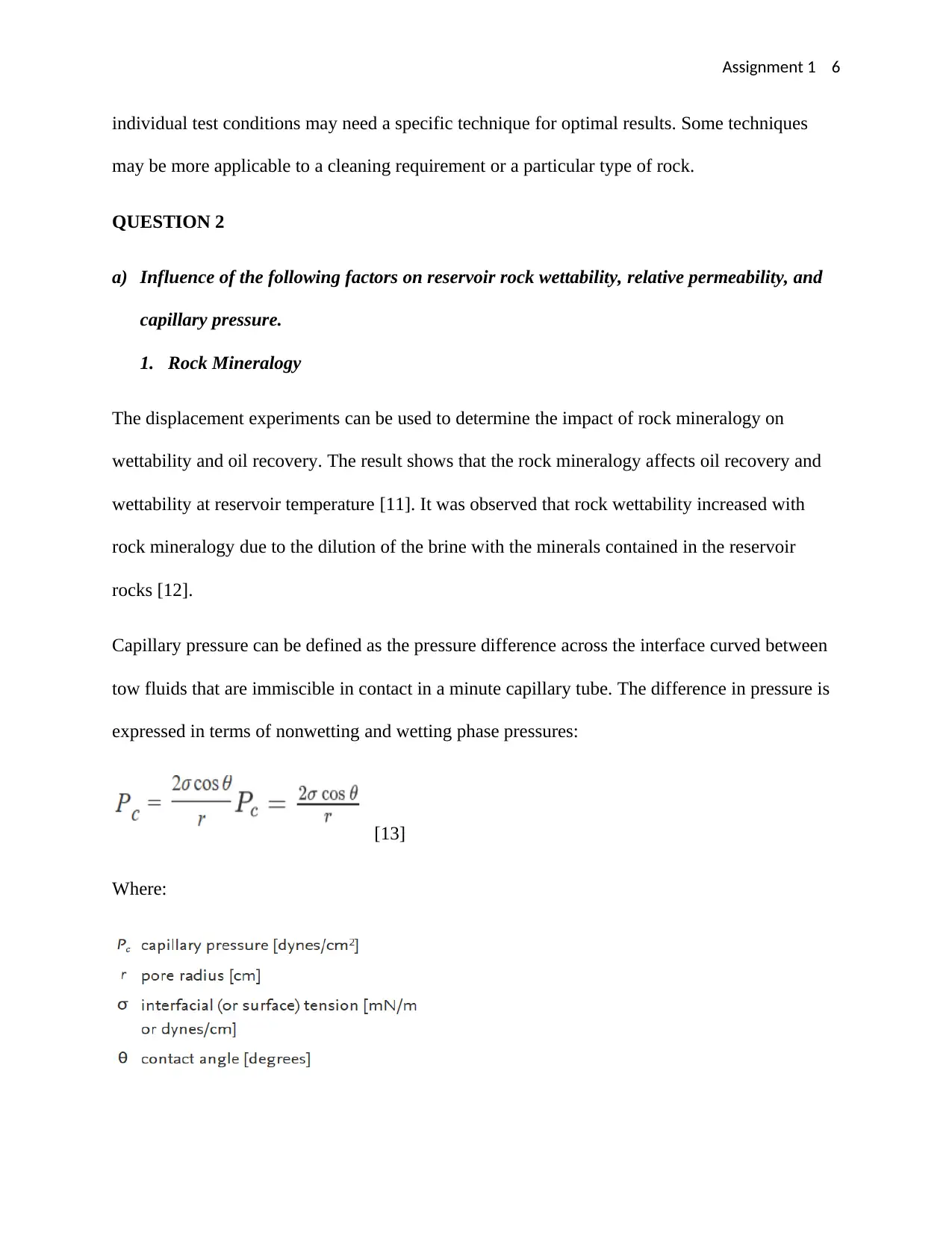
Assignment 1 6
individual test conditions may need a specific technique for optimal results. Some techniques
may be more applicable to a cleaning requirement or a particular type of rock.
QUESTION 2
a) Influence of the following factors on reservoir rock wettability, relative permeability, and
capillary pressure.
1. Rock Mineralogy
The displacement experiments can be used to determine the impact of rock mineralogy on
wettability and oil recovery. The result shows that the rock mineralogy affects oil recovery and
wettability at reservoir temperature [11]. It was observed that rock wettability increased with
rock mineralogy due to the dilution of the brine with the minerals contained in the reservoir
rocks [12].
Capillary pressure can be defined as the pressure difference across the interface curved between
tow fluids that are immiscible in contact in a minute capillary tube. The difference in pressure is
expressed in terms of nonwetting and wetting phase pressures:
[13]
Where:
individual test conditions may need a specific technique for optimal results. Some techniques
may be more applicable to a cleaning requirement or a particular type of rock.
QUESTION 2
a) Influence of the following factors on reservoir rock wettability, relative permeability, and
capillary pressure.
1. Rock Mineralogy
The displacement experiments can be used to determine the impact of rock mineralogy on
wettability and oil recovery. The result shows that the rock mineralogy affects oil recovery and
wettability at reservoir temperature [11]. It was observed that rock wettability increased with
rock mineralogy due to the dilution of the brine with the minerals contained in the reservoir
rocks [12].
Capillary pressure can be defined as the pressure difference across the interface curved between
tow fluids that are immiscible in contact in a minute capillary tube. The difference in pressure is
expressed in terms of nonwetting and wetting phase pressures:
[13]
Where:
⊘ This is a preview!⊘
Do you want full access?
Subscribe today to unlock all pages.

Trusted by 1+ million students worldwide
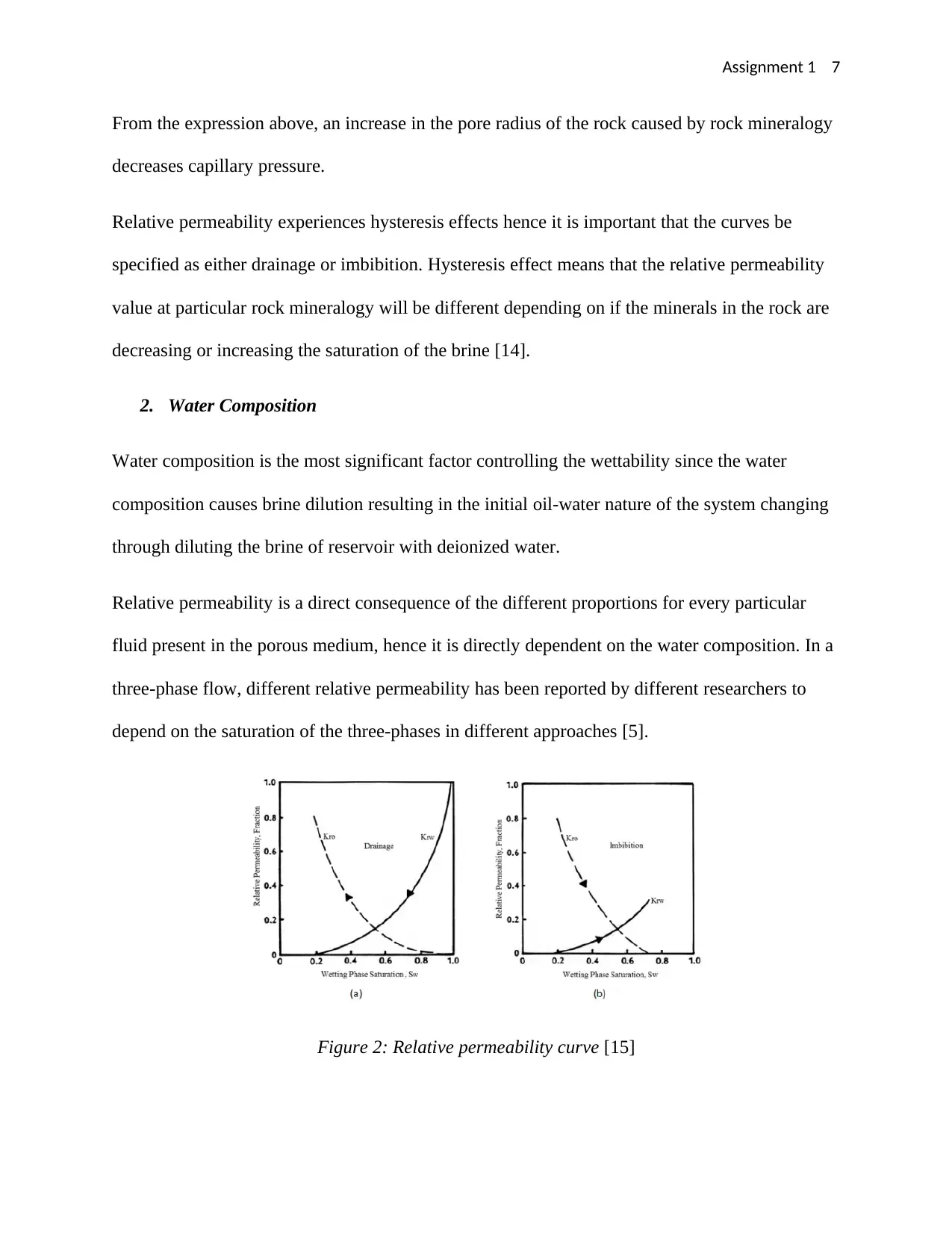
Assignment 1 7
From the expression above, an increase in the pore radius of the rock caused by rock mineralogy
decreases capillary pressure.
Relative permeability experiences hysteresis effects hence it is important that the curves be
specified as either drainage or imbibition. Hysteresis effect means that the relative permeability
value at particular rock mineralogy will be different depending on if the minerals in the rock are
decreasing or increasing the saturation of the brine [14].
2. Water Composition
Water composition is the most significant factor controlling the wettability since the water
composition causes brine dilution resulting in the initial oil-water nature of the system changing
through diluting the brine of reservoir with deionized water.
Relative permeability is a direct consequence of the different proportions for every particular
fluid present in the porous medium, hence it is directly dependent on the water composition. In a
three-phase flow, different relative permeability has been reported by different researchers to
depend on the saturation of the three-phases in different approaches [5].
Figure 2: Relative permeability curve [15]
From the expression above, an increase in the pore radius of the rock caused by rock mineralogy
decreases capillary pressure.
Relative permeability experiences hysteresis effects hence it is important that the curves be
specified as either drainage or imbibition. Hysteresis effect means that the relative permeability
value at particular rock mineralogy will be different depending on if the minerals in the rock are
decreasing or increasing the saturation of the brine [14].
2. Water Composition
Water composition is the most significant factor controlling the wettability since the water
composition causes brine dilution resulting in the initial oil-water nature of the system changing
through diluting the brine of reservoir with deionized water.
Relative permeability is a direct consequence of the different proportions for every particular
fluid present in the porous medium, hence it is directly dependent on the water composition. In a
three-phase flow, different relative permeability has been reported by different researchers to
depend on the saturation of the three-phases in different approaches [5].
Figure 2: Relative permeability curve [15]
Paraphrase This Document
Need a fresh take? Get an instant paraphrase of this document with our AI Paraphraser
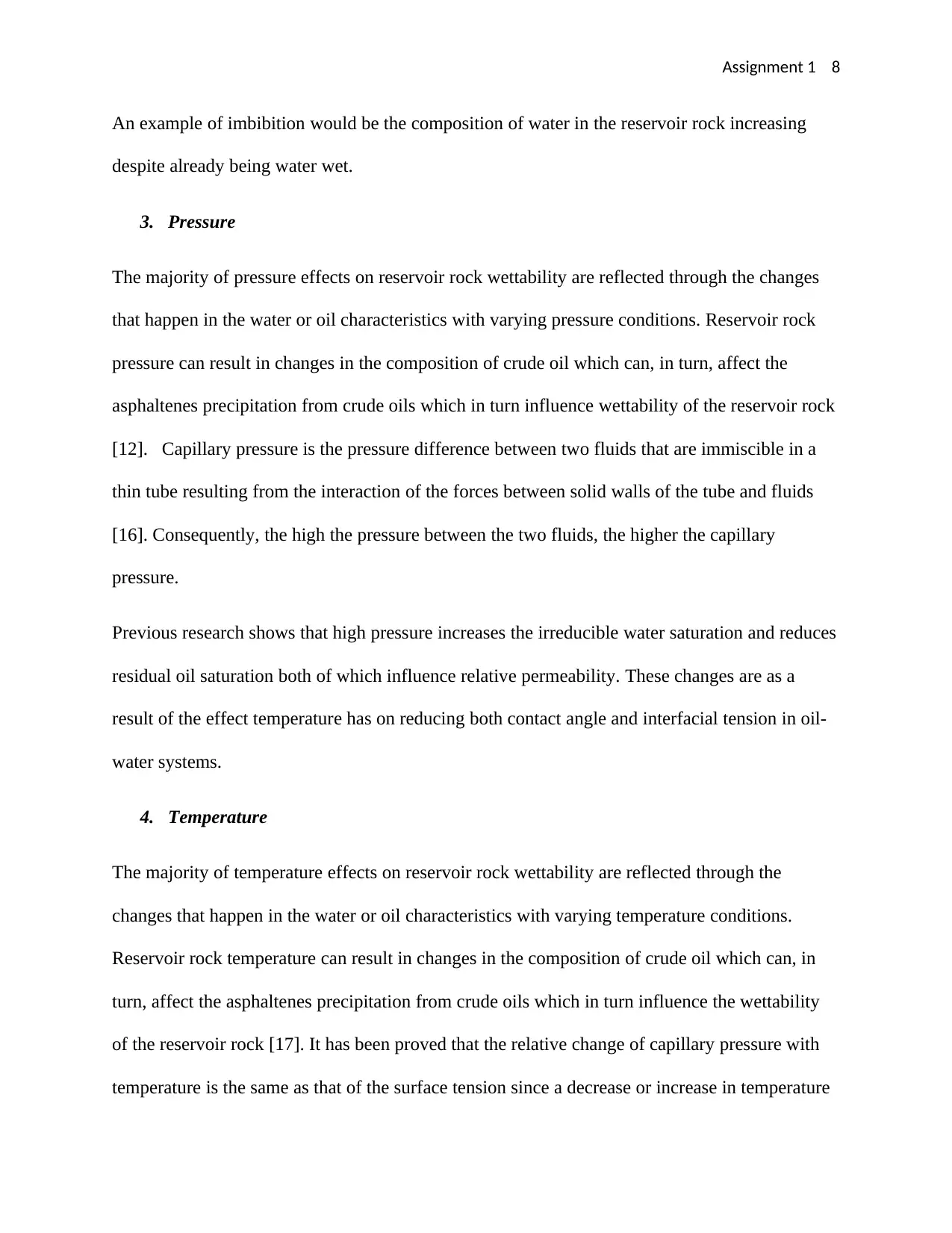
Assignment 1 8
An example of imbibition would be the composition of water in the reservoir rock increasing
despite already being water wet.
3. Pressure
The majority of pressure effects on reservoir rock wettability are reflected through the changes
that happen in the water or oil characteristics with varying pressure conditions. Reservoir rock
pressure can result in changes in the composition of crude oil which can, in turn, affect the
asphaltenes precipitation from crude oils which in turn influence wettability of the reservoir rock
[12]. Capillary pressure is the pressure difference between two fluids that are immiscible in a
thin tube resulting from the interaction of the forces between solid walls of the tube and fluids
[16]. Consequently, the high the pressure between the two fluids, the higher the capillary
pressure.
Previous research shows that high pressure increases the irreducible water saturation and reduces
residual oil saturation both of which influence relative permeability. These changes are as a
result of the effect temperature has on reducing both contact angle and interfacial tension in oil-
water systems.
4. Temperature
The majority of temperature effects on reservoir rock wettability are reflected through the
changes that happen in the water or oil characteristics with varying temperature conditions.
Reservoir rock temperature can result in changes in the composition of crude oil which can, in
turn, affect the asphaltenes precipitation from crude oils which in turn influence the wettability
of the reservoir rock [17]. It has been proved that the relative change of capillary pressure with
temperature is the same as that of the surface tension since a decrease or increase in temperature
An example of imbibition would be the composition of water in the reservoir rock increasing
despite already being water wet.
3. Pressure
The majority of pressure effects on reservoir rock wettability are reflected through the changes
that happen in the water or oil characteristics with varying pressure conditions. Reservoir rock
pressure can result in changes in the composition of crude oil which can, in turn, affect the
asphaltenes precipitation from crude oils which in turn influence wettability of the reservoir rock
[12]. Capillary pressure is the pressure difference between two fluids that are immiscible in a
thin tube resulting from the interaction of the forces between solid walls of the tube and fluids
[16]. Consequently, the high the pressure between the two fluids, the higher the capillary
pressure.
Previous research shows that high pressure increases the irreducible water saturation and reduces
residual oil saturation both of which influence relative permeability. These changes are as a
result of the effect temperature has on reducing both contact angle and interfacial tension in oil-
water systems.
4. Temperature
The majority of temperature effects on reservoir rock wettability are reflected through the
changes that happen in the water or oil characteristics with varying temperature conditions.
Reservoir rock temperature can result in changes in the composition of crude oil which can, in
turn, affect the asphaltenes precipitation from crude oils which in turn influence the wettability
of the reservoir rock [17]. It has been proved that the relative change of capillary pressure with
temperature is the same as that of the surface tension since a decrease or increase in temperature
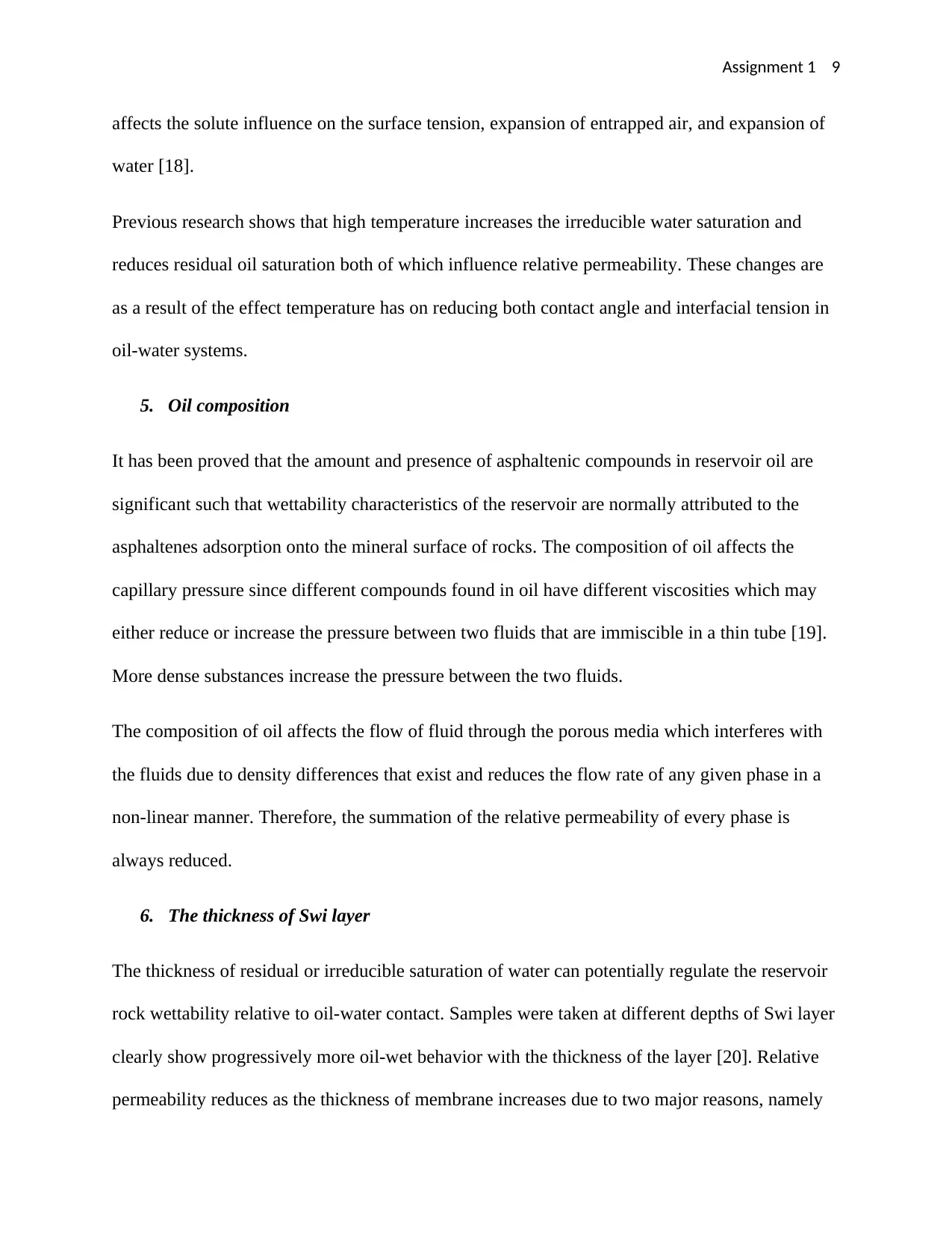
Assignment 1 9
affects the solute influence on the surface tension, expansion of entrapped air, and expansion of
water [18].
Previous research shows that high temperature increases the irreducible water saturation and
reduces residual oil saturation both of which influence relative permeability. These changes are
as a result of the effect temperature has on reducing both contact angle and interfacial tension in
oil-water systems.
5. Oil composition
It has been proved that the amount and presence of asphaltenic compounds in reservoir oil are
significant such that wettability characteristics of the reservoir are normally attributed to the
asphaltenes adsorption onto the mineral surface of rocks. The composition of oil affects the
capillary pressure since different compounds found in oil have different viscosities which may
either reduce or increase the pressure between two fluids that are immiscible in a thin tube [19].
More dense substances increase the pressure between the two fluids.
The composition of oil affects the flow of fluid through the porous media which interferes with
the fluids due to density differences that exist and reduces the flow rate of any given phase in a
non-linear manner. Therefore, the summation of the relative permeability of every phase is
always reduced.
6. The thickness of Swi layer
The thickness of residual or irreducible saturation of water can potentially regulate the reservoir
rock wettability relative to oil-water contact. Samples were taken at different depths of Swi layer
clearly show progressively more oil-wet behavior with the thickness of the layer [20]. Relative
permeability reduces as the thickness of membrane increases due to two major reasons, namely
affects the solute influence on the surface tension, expansion of entrapped air, and expansion of
water [18].
Previous research shows that high temperature increases the irreducible water saturation and
reduces residual oil saturation both of which influence relative permeability. These changes are
as a result of the effect temperature has on reducing both contact angle and interfacial tension in
oil-water systems.
5. Oil composition
It has been proved that the amount and presence of asphaltenic compounds in reservoir oil are
significant such that wettability characteristics of the reservoir are normally attributed to the
asphaltenes adsorption onto the mineral surface of rocks. The composition of oil affects the
capillary pressure since different compounds found in oil have different viscosities which may
either reduce or increase the pressure between two fluids that are immiscible in a thin tube [19].
More dense substances increase the pressure between the two fluids.
The composition of oil affects the flow of fluid through the porous media which interferes with
the fluids due to density differences that exist and reduces the flow rate of any given phase in a
non-linear manner. Therefore, the summation of the relative permeability of every phase is
always reduced.
6. The thickness of Swi layer
The thickness of residual or irreducible saturation of water can potentially regulate the reservoir
rock wettability relative to oil-water contact. Samples were taken at different depths of Swi layer
clearly show progressively more oil-wet behavior with the thickness of the layer [20]. Relative
permeability reduces as the thickness of membrane increases due to two major reasons, namely
⊘ This is a preview!⊘
Do you want full access?
Subscribe today to unlock all pages.

Trusted by 1+ million students worldwide
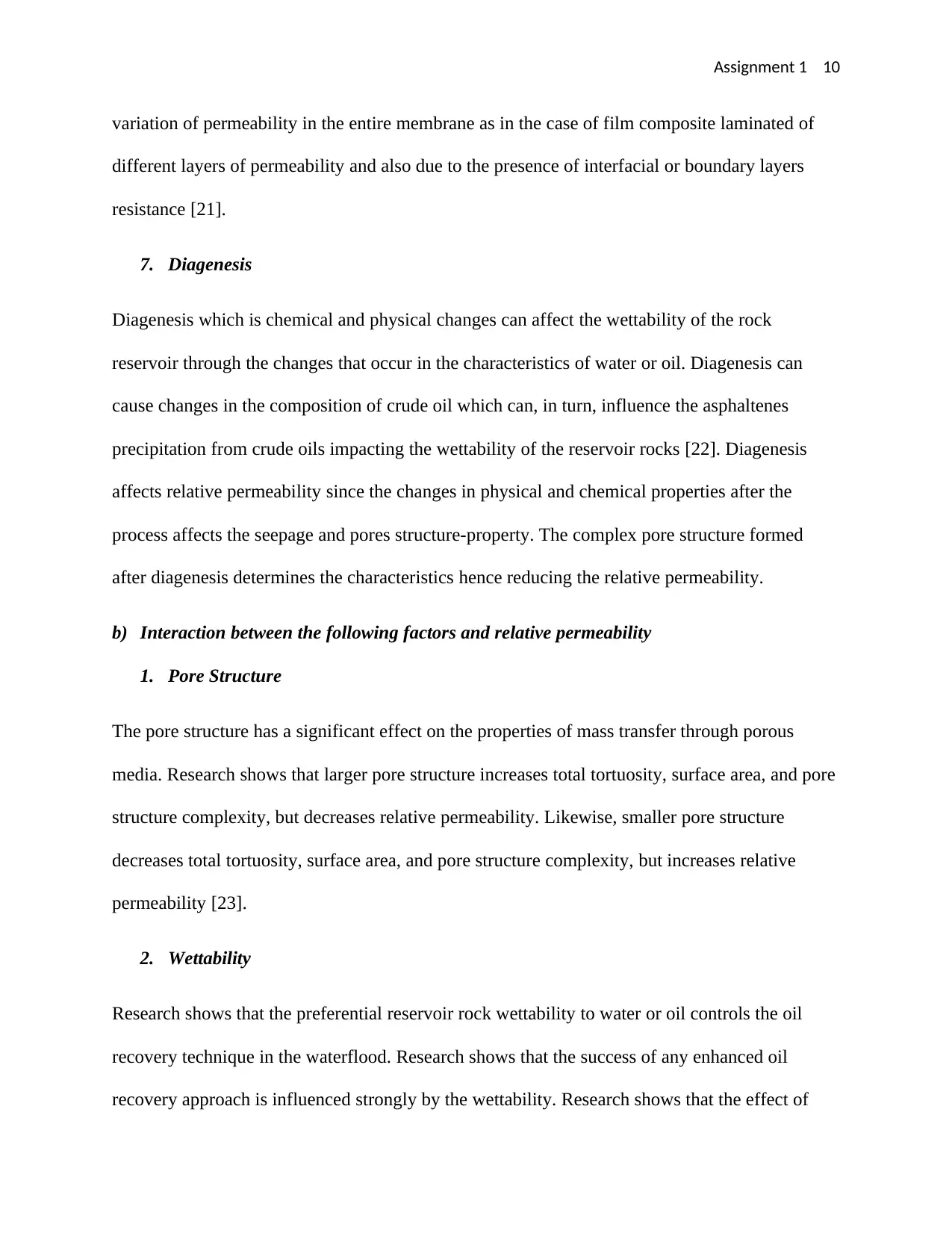
Assignment 1 10
variation of permeability in the entire membrane as in the case of film composite laminated of
different layers of permeability and also due to the presence of interfacial or boundary layers
resistance [21].
7. Diagenesis
Diagenesis which is chemical and physical changes can affect the wettability of the rock
reservoir through the changes that occur in the characteristics of water or oil. Diagenesis can
cause changes in the composition of crude oil which can, in turn, influence the asphaltenes
precipitation from crude oils impacting the wettability of the reservoir rocks [22]. Diagenesis
affects relative permeability since the changes in physical and chemical properties after the
process affects the seepage and pores structure-property. The complex pore structure formed
after diagenesis determines the characteristics hence reducing the relative permeability.
b) Interaction between the following factors and relative permeability
1. Pore Structure
The pore structure has a significant effect on the properties of mass transfer through porous
media. Research shows that larger pore structure increases total tortuosity, surface area, and pore
structure complexity, but decreases relative permeability. Likewise, smaller pore structure
decreases total tortuosity, surface area, and pore structure complexity, but increases relative
permeability [23].
2. Wettability
Research shows that the preferential reservoir rock wettability to water or oil controls the oil
recovery technique in the waterflood. Research shows that the success of any enhanced oil
recovery approach is influenced strongly by the wettability. Research shows that the effect of
variation of permeability in the entire membrane as in the case of film composite laminated of
different layers of permeability and also due to the presence of interfacial or boundary layers
resistance [21].
7. Diagenesis
Diagenesis which is chemical and physical changes can affect the wettability of the rock
reservoir through the changes that occur in the characteristics of water or oil. Diagenesis can
cause changes in the composition of crude oil which can, in turn, influence the asphaltenes
precipitation from crude oils impacting the wettability of the reservoir rocks [22]. Diagenesis
affects relative permeability since the changes in physical and chemical properties after the
process affects the seepage and pores structure-property. The complex pore structure formed
after diagenesis determines the characteristics hence reducing the relative permeability.
b) Interaction between the following factors and relative permeability
1. Pore Structure
The pore structure has a significant effect on the properties of mass transfer through porous
media. Research shows that larger pore structure increases total tortuosity, surface area, and pore
structure complexity, but decreases relative permeability. Likewise, smaller pore structure
decreases total tortuosity, surface area, and pore structure complexity, but increases relative
permeability [23].
2. Wettability
Research shows that the preferential reservoir rock wettability to water or oil controls the oil
recovery technique in the waterflood. Research shows that the success of any enhanced oil
recovery approach is influenced strongly by the wettability. Research shows that the effect of
Paraphrase This Document
Need a fresh take? Get an instant paraphrase of this document with our AI Paraphraser
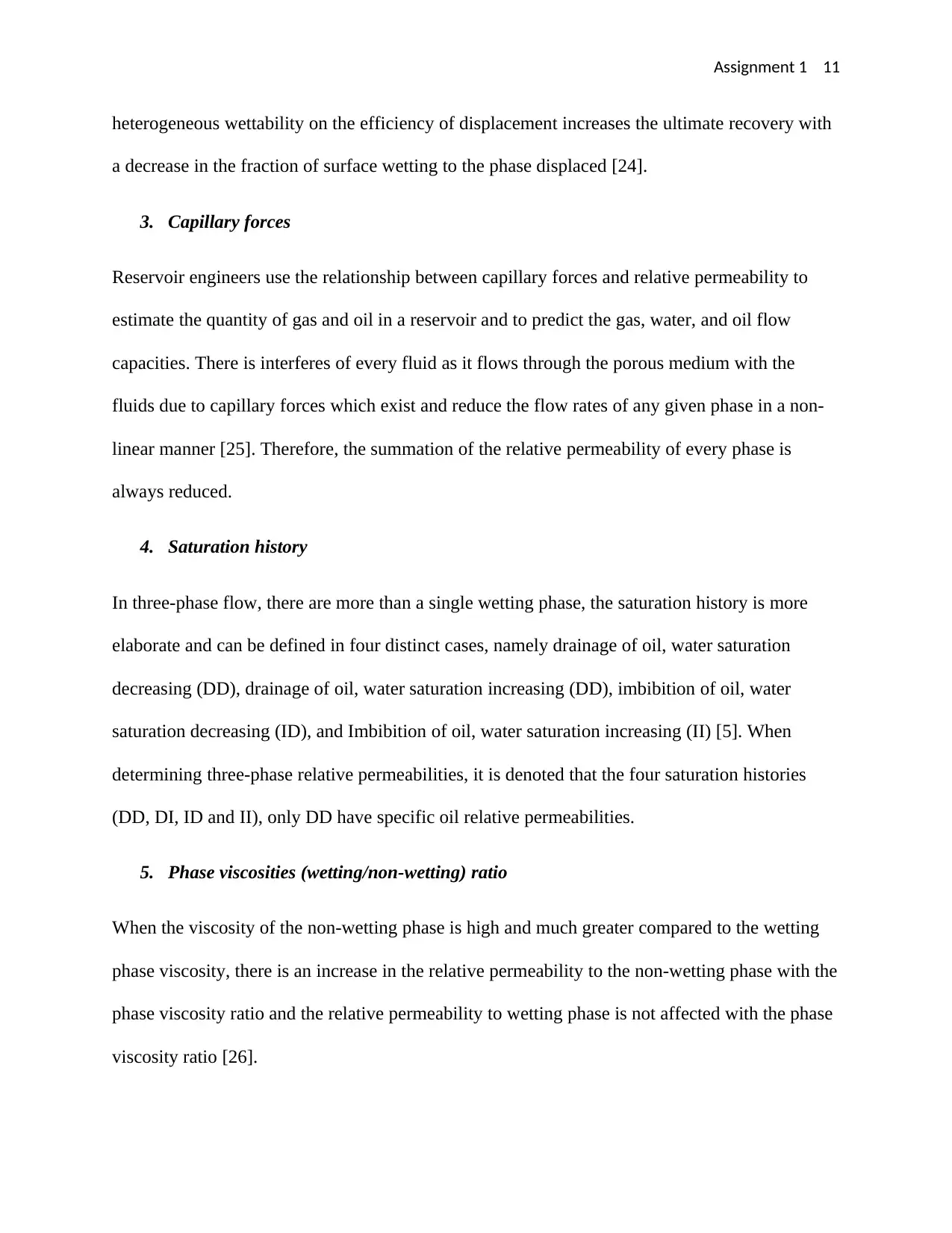
Assignment 1 11
heterogeneous wettability on the efficiency of displacement increases the ultimate recovery with
a decrease in the fraction of surface wetting to the phase displaced [24].
3. Capillary forces
Reservoir engineers use the relationship between capillary forces and relative permeability to
estimate the quantity of gas and oil in a reservoir and to predict the gas, water, and oil flow
capacities. There is interferes of every fluid as it flows through the porous medium with the
fluids due to capillary forces which exist and reduce the flow rates of any given phase in a non-
linear manner [25]. Therefore, the summation of the relative permeability of every phase is
always reduced.
4. Saturation history
In three-phase flow, there are more than a single wetting phase, the saturation history is more
elaborate and can be defined in four distinct cases, namely drainage of oil, water saturation
decreasing (DD), drainage of oil, water saturation increasing (DD), imbibition of oil, water
saturation decreasing (ID), and Imbibition of oil, water saturation increasing (II) [5]. When
determining three-phase relative permeabilities, it is denoted that the four saturation histories
(DD, DI, ID and II), only DD have specific oil relative permeabilities.
5. Phase viscosities (wetting/non-wetting) ratio
When the viscosity of the non-wetting phase is high and much greater compared to the wetting
phase viscosity, there is an increase in the relative permeability to the non-wetting phase with the
phase viscosity ratio and the relative permeability to wetting phase is not affected with the phase
viscosity ratio [26].
heterogeneous wettability on the efficiency of displacement increases the ultimate recovery with
a decrease in the fraction of surface wetting to the phase displaced [24].
3. Capillary forces
Reservoir engineers use the relationship between capillary forces and relative permeability to
estimate the quantity of gas and oil in a reservoir and to predict the gas, water, and oil flow
capacities. There is interferes of every fluid as it flows through the porous medium with the
fluids due to capillary forces which exist and reduce the flow rates of any given phase in a non-
linear manner [25]. Therefore, the summation of the relative permeability of every phase is
always reduced.
4. Saturation history
In three-phase flow, there are more than a single wetting phase, the saturation history is more
elaborate and can be defined in four distinct cases, namely drainage of oil, water saturation
decreasing (DD), drainage of oil, water saturation increasing (DD), imbibition of oil, water
saturation decreasing (ID), and Imbibition of oil, water saturation increasing (II) [5]. When
determining three-phase relative permeabilities, it is denoted that the four saturation histories
(DD, DI, ID and II), only DD have specific oil relative permeabilities.
5. Phase viscosities (wetting/non-wetting) ratio
When the viscosity of the non-wetting phase is high and much greater compared to the wetting
phase viscosity, there is an increase in the relative permeability to the non-wetting phase with the
phase viscosity ratio and the relative permeability to wetting phase is not affected with the phase
viscosity ratio [26].
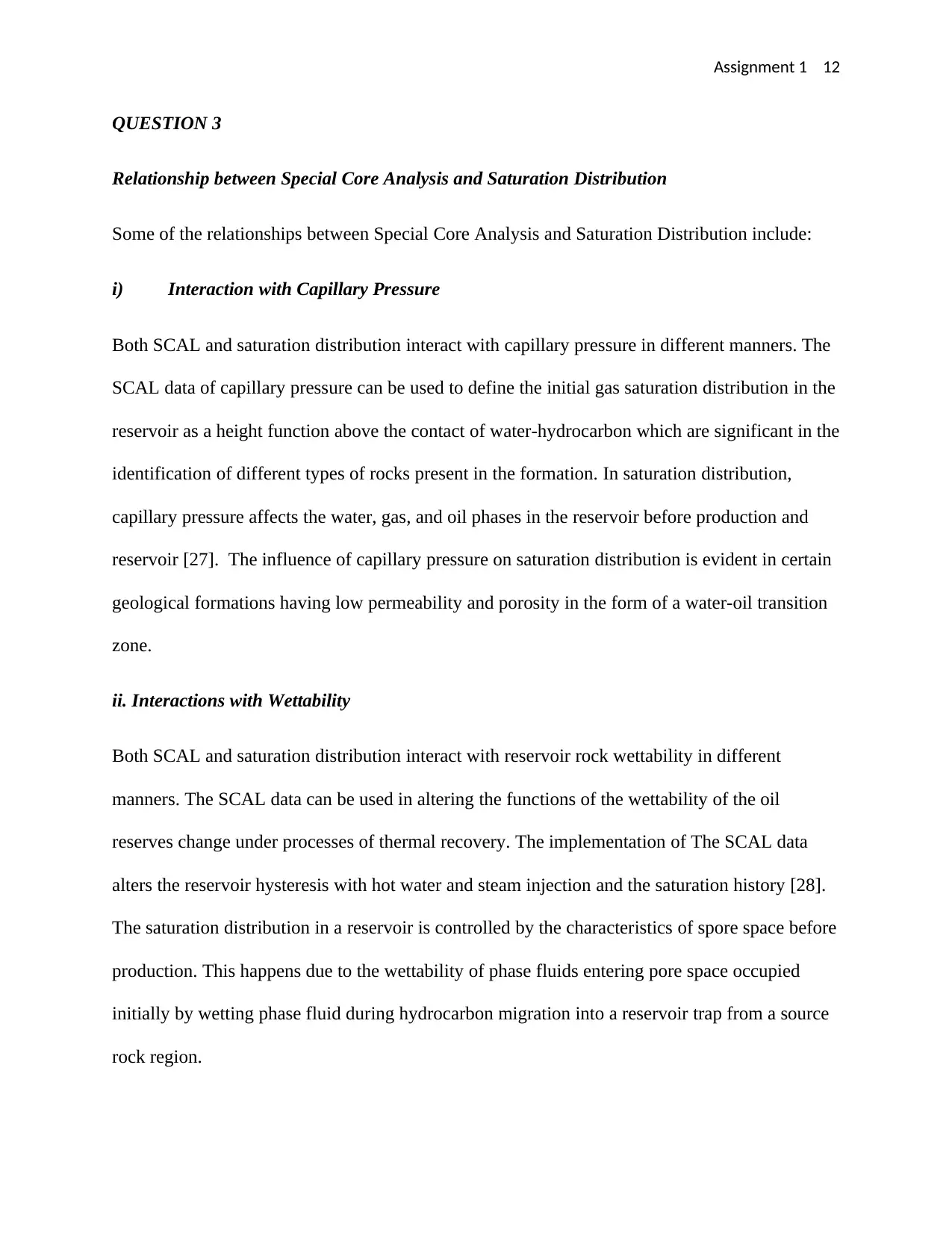
Assignment 1 12
QUESTION 3
Relationship between Special Core Analysis and Saturation Distribution
Some of the relationships between Special Core Analysis and Saturation Distribution include:
i) Interaction with Capillary Pressure
Both SCAL and saturation distribution interact with capillary pressure in different manners. The
SCAL data of capillary pressure can be used to define the initial gas saturation distribution in the
reservoir as a height function above the contact of water-hydrocarbon which are significant in the
identification of different types of rocks present in the formation. In saturation distribution,
capillary pressure affects the water, gas, and oil phases in the reservoir before production and
reservoir [27]. The influence of capillary pressure on saturation distribution is evident in certain
geological formations having low permeability and porosity in the form of a water-oil transition
zone.
ii. Interactions with Wettability
Both SCAL and saturation distribution interact with reservoir rock wettability in different
manners. The SCAL data can be used in altering the functions of the wettability of the oil
reserves change under processes of thermal recovery. The implementation of The SCAL data
alters the reservoir hysteresis with hot water and steam injection and the saturation history [28].
The saturation distribution in a reservoir is controlled by the characteristics of spore space before
production. This happens due to the wettability of phase fluids entering pore space occupied
initially by wetting phase fluid during hydrocarbon migration into a reservoir trap from a source
rock region.
QUESTION 3
Relationship between Special Core Analysis and Saturation Distribution
Some of the relationships between Special Core Analysis and Saturation Distribution include:
i) Interaction with Capillary Pressure
Both SCAL and saturation distribution interact with capillary pressure in different manners. The
SCAL data of capillary pressure can be used to define the initial gas saturation distribution in the
reservoir as a height function above the contact of water-hydrocarbon which are significant in the
identification of different types of rocks present in the formation. In saturation distribution,
capillary pressure affects the water, gas, and oil phases in the reservoir before production and
reservoir [27]. The influence of capillary pressure on saturation distribution is evident in certain
geological formations having low permeability and porosity in the form of a water-oil transition
zone.
ii. Interactions with Wettability
Both SCAL and saturation distribution interact with reservoir rock wettability in different
manners. The SCAL data can be used in altering the functions of the wettability of the oil
reserves change under processes of thermal recovery. The implementation of The SCAL data
alters the reservoir hysteresis with hot water and steam injection and the saturation history [28].
The saturation distribution in a reservoir is controlled by the characteristics of spore space before
production. This happens due to the wettability of phase fluids entering pore space occupied
initially by wetting phase fluid during hydrocarbon migration into a reservoir trap from a source
rock region.
⊘ This is a preview!⊘
Do you want full access?
Subscribe today to unlock all pages.

Trusted by 1+ million students worldwide
1 out of 15
Your All-in-One AI-Powered Toolkit for Academic Success.
+13062052269
info@desklib.com
Available 24*7 on WhatsApp / Email
![[object Object]](/_next/static/media/star-bottom.7253800d.svg)
Unlock your academic potential
Copyright © 2020–2025 A2Z Services. All Rights Reserved. Developed and managed by ZUCOL.


